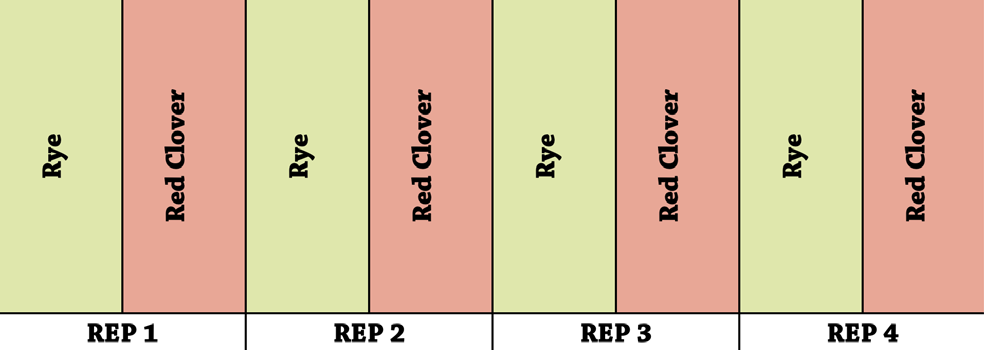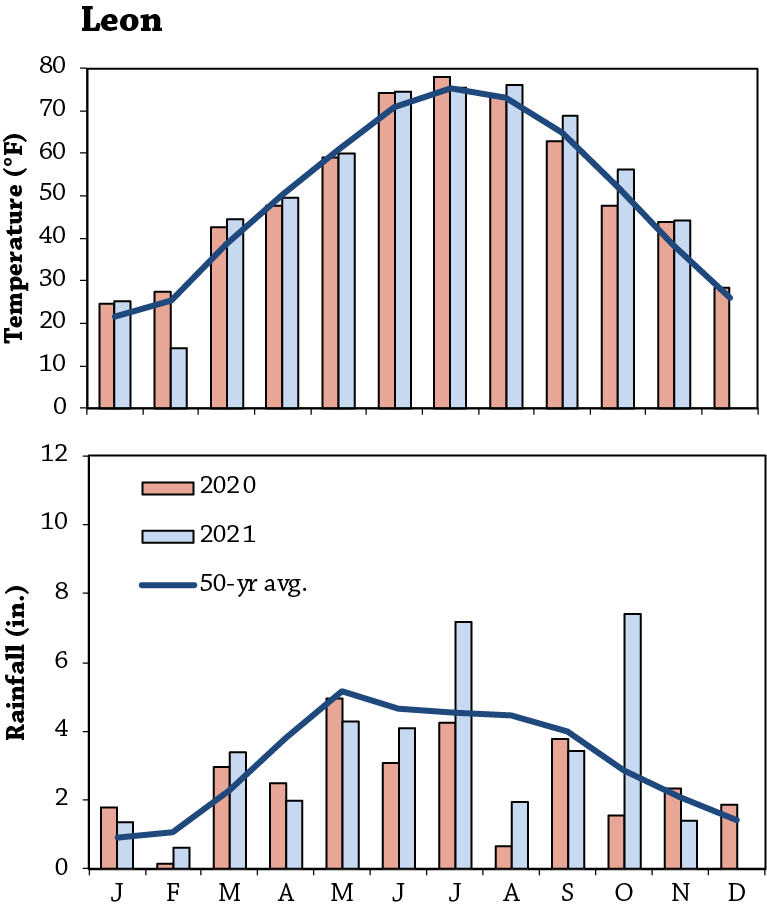This research was funded by the Walton Family Foundation.
In a Nutshell:
- July harvest of small-grains crops presents the opportunity to grow both nitrogen-fixing legume cover crops and forage cover crops for cattle grazing.
- In this project, Arlyn Kauffman frost-seeded clover cover crops into a cereal rye seed crop and intended to compare them to a cover crop mix seeded after cereal rye seed harvest in July. Dry conditions after rye seed harvest, however, precluded establishment of the cover crop mix. Ultimately, Kauffman compared the effects of red clover and cereal rye cover crops on corn yield.
Key Findings:
- Frost-seeding red clover resulted in greater corn yield by 41 bu/ac and a larger return on investment than the cereal rye cover crop.
Background
At the onset of this trial, Arlyn Kauffman set out to compare several green manure cover crops between the rye and corn phases of his crop rotation. Specifically, he frost-seeded red clover and balansa clover to the rye crop in March 2020 and intended to include a third treatment: a cover crop mix seeded after rye seed harvest in July 2020. Kauffman hypothesized that, provided timely summer rainfall, the summer mix would produce the most biomass and grazing value. Unfortunately, summer rainfall was too sparse for the summer mix to establish; the seeding was abandoned. Additionally, the frost-seeded balansa clover failed to establish. Kauffman was still eager to test the effect of red clover on corn yield, so eventually the following treatments comprised the trial:
- Red clover – medium red clover frost-seeded to rye March 2020; corn planted in 2021.
- Rye – volunteer rye cover crop seeded during rye seed harvest July 2020 with additional rye cover crop drilled in October 2020; corn planted in 2021.

Dark green corn in a strip that followed a red clover cover crop. “They were SOOO green,” Kauffman said. “It was astonishing from the road to see the difference in corn color. From the air, even more.” The neighboring strips had a cereal rye cover crop. Photo taken July 7, 2021.
Methods
Design
On Nov. 15, 2019, Kauffman drilled a cereal rye seed crop in 10-in. rows at 80 lb/ac on land that had previously been planted to corn. Kauffman frost-seeded medium red clover (9 lb/ac) into the cereal rye crop in strips on March 10, 2020; this was just before the cereal rye crop broke winter dormancy. On July 22, Kauffman harvested the rye; a volunteer rye cover crop stand was established from seed blown out the back of the combine during harvest. Kauffman hayed the entire field (clover and rye straw) in late July. In the strips with volunteer rye, Kauffman drilled additional rye cover crop seed in October at 90 lb/ac. Liquid hog manure (2,000 gal/ac) was applied to all strips in early November and cattle grazed the entire field from Nov. 15 to Dec. 25.
On Apr. 26, 2021, Kauffman planted corn in 30-in. rows at a population of 31,500 seeds/ac. With the planter, he applied 20 gal/ac of “UAN(29)” – UAN(32) diluted with 10% ammonium thiosulfate. The red clover and rye cover crops were terminated five days later on May 1 with glyphosate (32 oz/ac) and 2,4-D (0.24 qt/ac). Kauffman sidedressed all strips with 58 lb N/ac as urea on July 1. An additional spray pass was made on May 21 to control weeds: Stalwart (2 qt/ac) and ATZ (0.5 qt/ac).
Measurements
Kauffman harvested corn and recorded yields from each individual strip on Oct. 15. Yields were adjusted to standard moisture (15.5%).
Data analysis
To evaluate the effect of cover crop on corn yield and profitability, we calculated the least significant difference (LSD) at the 95% confidence level using a t-test. If the difference in average yield resulting from the two cover crop treatments was greater than the LSD, we would expect such a difference to occur 95 times out of 100 under the same conditions – we refer to this as a statistically significant effect. On the other hand, if the difference resulting from the two treatments was less than the LSD, we would consider the results to be statistically similar. We could make these statistical calculations because Kauffman’s experimental design involved replication of the two treatments (Figure A1).
Results and Discussion
Corn yield
Corn that followed red clover statistically out-yielded corn following the rye cover crop by 41 bu/ac (Figure 1). Yields fell considerably short of Kauffman’s county’s five-year average (Decatur = 171 bu/ac).[1] “One challenge we had was very slow corn emergence and a poor stand in the clover due to shading and cool soil temperatures,” Kauffman said. “If there would have been a full stand it could have gone another 30 bushels higher.” Despite this, his results further illustrate superior corn agronomic performance when following legume cover crops that have also been shown in previous PFI on-farm research [2,3] and academic research.[4,5]

FIGURE 1. Corn yields at Arlyn Kauffman’s in 2021. Columns and values represent treatment averages; points represent yields from individual strips. Because the difference between the treatment averages (41 bu/ac) is greater than the least significant difference (LSD = 35 bu/ac), the treatment yields are considered statistically different at the 95% confidence level. We indicate this with an asterisk (*).
Economic considerations
The return on investment was more than $200/ac greater in the clover treatment than in the rye treatment (Table 1). The significantly greater corn yield coupled with the lower total cost of the clover treatment translated to greater revenue.
Conclusions and Next Steps
“Needless to say, we are ordering medium red clover to underseed to our small grain next year going to corn in 2023!” Kauffman said of his results. “In an extended rotation that includes a small grain followed by corn, this has to be about the lowest-hanging-fruit practice a person could imagine, based on what we learned.” After observing slow emergence of corn planted into cover crops this year, Kauffman is reconsidering his typical practice of planting corn in April and instead planting in May when soil temperatures are higher. Ultimately, Kauffman was pleased to see for himself what other farmers have observed and shared over the years: “[This trial] built my confidence that using clover to drastically reduce commercial N is a real thing!”

Dark green strips depict where corn followed the red clover cover crop; lighter green where corn followed the rye cover crop. Photo taken July 13, 2021.
Appendix – Trial Design and Weather Conditions

FIGURE A1. Arlyn Kauffman’s experimental design consisted of four replications of both treatments (8 strips total). This design allowed for statistical analysis of the data.

FIGURE A2. Mean monthly temperature and rainfall during the trial period and the long-term averages at Leon, the nearest weather station to Kauffman’s farm.[7]
References
- US Department of Agriculture-National Agricultural Statistics Service. Quick stats. USDA-National Agricultural Statistics Service. https://quickstats.nass.usda.gov/ (accessed November 2021).
- Gailans, S. and W. Dooley. 2016. Effect on corn of green manure cover crops established with cereal rye seed crop. Practical Farmers of Iowa Cooperators’ Program. https://practicalfarmers.org/research/effect-on-corn-of-green-manure-cover-crops-established-with-cereal-rye-seed-crop/ (accessed November 2021).
- Nelson, H. and T. Frantzen. 2021. Interseeded and Summer-seeded Green Manure Cover Crops for an Organic Hybrid Rye-Corn System. Practical Farmers of Iowa Cooperators’ Program. https://practicalfarmers.org/research/interseeded-and-summer-seeded-green-manure-cover-crops-for-an-organic-hybrid-rye-corn-system/ (accessed November 2021).
- Liebman, M., R.L. Graef, D. Nettleton and C.A. Cambardella. 2012. Use of legume green manures as nitrogen sources for corn production. Renewable Agriculture and Food Systems. 27:180–191. https://lib.dr.iastate.edu/cgi/viewcontent.cgi?article=1202&context=stat_las_pubs (accessed November 2021).
- Marcillo, G.S. and F.E. Miguez. 2017. Corn yield response to winter cover crops: An updated meta-analysis. Journal of Soil and Water Conservation. 72:226–
239. http://www.jswconline.org/content/72/3/226.short (accessed November 2021). - Plastina, A. 2021. 2021 Iowa Farm Custom Rate Survey. Iowa State University Extension and Outreach. https://www.extension.iastate.edu/agdm/crops/pdf/a3-10.pdf (accessed November 2021).
- Iowa Environmental Mesonet. 2021. Climodat Reports. Iowa State University. http://mesonet.agron.iastate.edu/climodat/ (accessed November 2021).



